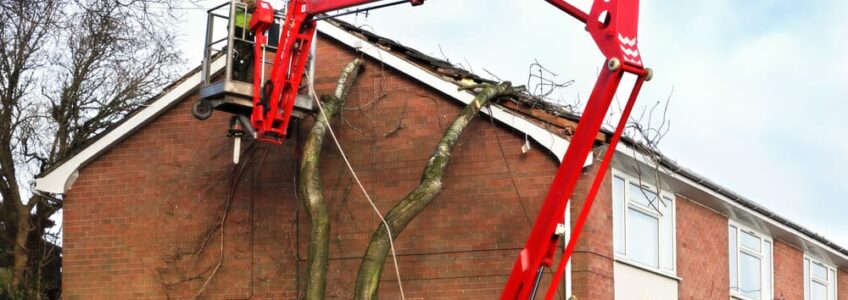
If your home has recently suffered from storm damage, you know how devastating it can be. Repairs can set you back, and it may take time until your insurance company reimburses you. The biggest concern is keeping your family safe, and getting your home back to normal.
Preparing before a weather event eases your worry and allows for smooth restoration once the storm has passed. For instance, if you live in a storm-prone area, having a shelter you can use to wait out the storm is recommended. An emergency fund also comes in handy if damage occurs to help cover unexpected expenses. Also, knowing what steps to take after a storm can help you return to your everyday life in no time.
After a storm hits, you need to take action quickly to remedy the situation. You can assess the damage, file insurance claims, and hire a contractor. The sooner you act, the sooner you can go back to your routine.
This blog post not only shares some helpful tips to guide you in navigating storm damage, but also details the best way to manage storm damage as quickly and efficiently as possible. Let’s get started.
Check for Storm Damage
After a storm damages your home, completing a walk-through with an experienced storm damage expert will help you determine whether your family needs to find temporary shelter or if the house is habitable. During the walk-through, your storm damage specialist will help you keep an eye out for:
- Broken glass
- Slippery floors
- Exposed or broken power lines
- Standing water
- Collapsed roofing structures
- Gas leaks
- And more
If you suspect a gas leak, the main valve must be shut off and windows must be opened immediately. After doing so, go outside and notify your gas company and the authorities. You must not enter your home until it is safe to return. If the home is extensively damaged, you and your family will be moved to a safe place whether that be with friends, family, or a hotel. Having somewhere to stay will help relieve stress, and eliminate unnecessary expenses.
Assess the Damage and Take Photos
Before contacting your insurance company, it is crucial to take photos of the damage as the images will help ensure you are fully compensated. Below are a few of the areas your storm damage expert will inspect:
- Roof lifting and shingles: Take extra care if broken limbs or heavy debris are visible on the roof as this may indicate a compromised roofing structure. Be on the lookout for holes or leaks and split seams on the roof. Shingles, vents, gutters, and flashing may be dented, broken, or missing. The gutters and downspout should also be checked for debris.
- Exterior siding: The storm can damage the painting and bricks, but it can also tear off entire walls.
- Windows and doors: Flying debris may cause cracks, holes, and sometimes damaged frames and broken window panes.
- Outdoor appliances: Outdoor appliances like air conditioning units are prone to storm damage. Check for dents, holes, cracks, splitting, and dings.
- Basement flooding: If the area around the house is saturated, it may result in flooding, which damages the property’s foundation. It can lead to mold growth, which is a health hazard.
- Fire damage: If water enters the power outlets, it poses a fire risk, just like downed energized power lines.
- Moisture: If rainwater seeps into your home, it can damage the insulation, furniture, floor and cause mold growth.
- Personal items: Record any damage of personal items as homeowners insurance will cover it up to a certain limit.
Contact Your Insurance Agent
In addition to photos of the damage to your home, document all the extra expenses you incur, like hotel costs and other temporary living expenses. For reimbursement, save all receipts, including those for labor and materials during repair work. You can contact your insurance company or agent armed with the proof.
Since they are likely receiving many claims requests from the area, try using a multi-channel approach to get through quickly. Use email, telephone, and any other means of contacting them. If you wait too long, you may not get reimbursed. Also, the longer you wait, the more severe the damage can become.
Your homeowners insurance will advise you on the way forward. They will issue you with a claims number and answer any questions. An agent will then determine what your plan covers. The process may take several months, but most insurance companies will pay after you have reached your deductible. Calculate your deductible to determine if filing a claim is the best step. Most homes have percent-based deductibles. If it doesn’t make financial sense to file a claim, you can pay for repairs out-of-pocket.
What Is Covered and What Isn’t?
Educating yourself on insurance policies prepares you for when you have to file a claim. If you live in storm-prone areas, having storm insurance is prudent. Homeowners insurance covers (non weather) theft and vandalism, weather damage from hail, storm, snow, etc., and accidental events like a broken water pipe. Insurance can help you restore your home, and minimize the damage to your wallet should a storm damage your home.
Avoid Further Damages to Your Home
To ensure you get back to your routine as soon as possible, you will be forced to do some repairs. Begin mending what you can to prevent further damage. For example, boarding up windows with plywood prevents water and debris from entering, while a tarp can cover holes on the roof to avoid more water damage.
Basement flooding is also a major health risk if left standing for long, as it can lead to the growth of mold and mildew. If you have a working sump pump, use it to get rid of the water. If it’s broken, a plumber can fix it for you. Turn the power off before stepping into the standing water to avoid electric shock, especially if electric wires are broken or damaged.
Another step to prevent further damage is ensuring your gutter system and downspouts are free of debris. If they are blocked, the stormwater will not be able to flow from your property freely, causing further flooding and seeping moisture into your home. The ground may be slippery, so make sure you secure yourself when cleaning the gutter.
If you can’t undertake these repairs yourself, look for a local construction company like Advantage Construction to help you. The local home builders association is an excellent place to look for recommendations. Your insurance company can also help you find a reputable company to avoid scams.
Choose the Right Contractor and Start Repair Works
Getting your home to pre-storm conditions will take the services of the right contractor. Half-baked work could leave you with serious health hazards, and sometimes an uninhabitable home. For instance, if you don’t remove floodwaters, it may lead to mold, and damage from the flooding can cause a compromised foundation. The sooner the repairs are done, the sooner your life can return to normal.
Gather quotes from different contractors and compare them to determine which is the most suitable. But remember, the lowest does not always represent the best. Carry out due diligence to avoid being scammed. The company you choose should be efficient and fast if they are to finish the repair work within schedule.
Prepare for the Next Storm
If you live in a storm-prone area, think about reinforcing your home to withstand further damage during consecutive storms. After a storm damages your property, you are only thinking of how you can have repairs done and go back to normalcy. But it is an excellent time to talk to your contractor about the kind of reinforcement your property needs.
You can make the work easier by having the reinforcements and repairs done together. You may not prevent the storm, but you can minimize the damage it causes to your home and the interruptions to your lives. Also, knowing you have taken measures to protect your family and home eases your worries.
Do You Need Storm Damage Repair?
At Advantage Construction, we put our customers’ needs first. We know storm damage is a significant interruption to your schedule, so we work efficiently to ensure we finish repair work within your schedule. Our team of qualified craftsmen pays keen attention to the smallest detail, so nothing is missed. We’ll assist you with your insurance claims during this devastating time. To learn more about how we can assist, contact us today.

